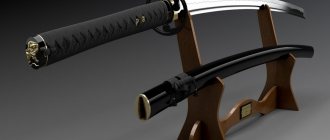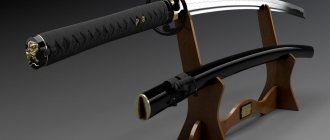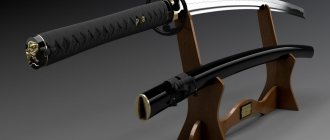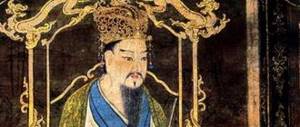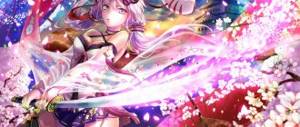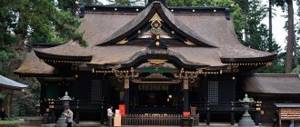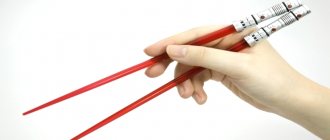Numerous wars and conflicts of Antiquity and the Middle Ages influenced not only the political structure of the world, but also the development of blacksmithing. Since battles were often decided by hand-to-hand combat, the emphasis was on improving melee weapons.
Throughout Europe and Asia, the art of forging was improved, achieving significant progress in some regions. Many technologies of those times made it possible to create high-quality swords, the hardening of which is superior to modern industrial products.
Katana is one of the Japanese swords famous for its quality. This weapon is credited with mythical properties and has become famous all over the world. Despite the lack of demand for edged weapons today, such swords continue to be forged as part of the cultural heritage of Japan.
The history of the appearance of the sword "Katana"
Katana and scabbard on a stand
Due to the late development of iron in Japan, weapons were imported from China and Korea for a long time. Only by the 7th century were blacksmiths able to master forging and processing multilayer steel. The first Japanese swords were straight and double-edged.
During the Heian period, in the 9th-12th centuries, in the context of horse fighting, weapons received a curved shape. Numerous internecine wars formed an entire class of samurai, for whom the sword became not only a weapon, but also a symbol. It was during this period that manufacturing technology was perfected.
During the Kamakura period from the 12th to the 14th centuries, armor improved, which required certain changes in bladed weapons. To increase the impact force, the weight increased and its shape changed. Such swords began to be used mainly in foot fights due to the complexity of fencing with one hand. This period is considered the heyday in the development of Japanese swords. Blacksmiths used unique technologies, many of which were subsequently lost.
During the Muromachi period from the 14th to the 16th centuries, various variations of Japanese swords appeared. Numerous wars required large quantities of edged weapons, and their quality has noticeably decreased. They were not allowed to purchase expensive weapons and constant ruin.
It was during this period that katanas developed. Their relevance arose against the backdrop of changes in fighting techniques, in which it was more important to get ahead of the opponent and strike the first blow. The appearance of slightly shorter swords marked the end of the Age of Old Swords.
The Momoyama period in the 16th century is characterized by the appearance of short swords. From this time on, wearing daisho (large-small) - katana and wakizashi - became relevant. The latter was more suitable for tight spaces.
This period marked the beginning of the Age of New Swords. Internecine wars subsided; peacetime no longer required large quantities of edged weapons. Japanese swords became part of the costume and a symbol of the owner's status. They were decorated with trim and decorative elements, often to the detriment of their fighting qualities.
In the second half of the 19th century, the Age of Modern Swords began. Weapons produced after 1868 are called gendai-to. Due to the ban on wearing it in 1876, many blacksmiths remained unclaimed, which led to a decline in production. At the beginning of the 20th century, in the context of a campaign to revive the country's cultural heritage, blacksmiths again received support.
How much does a katana cost?
How much a katana costs depends on the age of the weapon, the manufacturing method, the finishing features of the handle and sheath, but a modern “remake” of good quality can cost 10-60 thousand rubles. A product of a worse level costs only 3-4 thousand rubles. A real katana from Japan will cost 300-500 thousand rubles, and sometimes even higher if it is a copy from a famous master with supporting documents. In 1995, one of these was sold for 600 thousand dollars.
Where to buy real one from Japan
You can buy a katana from Japan in gun stores. There are products made in this country at the present time, but in accordance with previous traditions. They can also be ordered online at international sites.
In Russia and other countries there are private collectors of weapons, who also sometimes part with some of their weapons. But you need to remember: if the sword has signs of chemical weapons, you will need permission to own it.
Sword design
The design of a katana has many elements.
A katana belongs to complex swords made from several metals. Often two alloys are taken - soft for the core and hard for the outer side. The final design of the weapon is divided into many elements that determine the quality of the sword.
The general appearance of the katana has a slightly curved shape. The arc formed has a larger radius than its predecessor, tati. The curve of the sword (sori) is a consequence of the evolution of Japanese weapons and fighting techniques. Experiments were carried out in this direction for a long time until the current variation was achieved.
Blade
Components of a katana blade
The combination of a soft (viscous) core and a hard (hard) shell provides the weapon with long-term sharpness and toughness. Otherwise, hard steel would be brittle, and soft steel would quickly wear off.
The katana blade is sharpened only on one outer side. Numerous myths attribute phenomenal abilities to samurai swords, including cutting iron and stone. A carefully crafted and hardened katana blade is indeed highly durable, but its properties are often exaggerated.
The katana does not have clearly defined standards for bending, cross-section, thickness and other elements. They differ depending on the master, the blacksmith school and the purpose of the blade. For example, against armor the sword was made heavier with a wedge-shaped cross-section, and against opponents unprotected by armor a thin blade was suitable.
Handle
Elements of the handle
Making the handle is considered the final stage of creating a sword and follows after grinding the blade. The handle is secured to the shank using a conical bamboo wedge. Despite the apparent simplicity of the design, there are several components of the handle:
- habaki - a clutch that fixes the position of the sword;
- tsuba—guard;
- seppa - washers above and below the guard;
- footi - coupling between the guard and the handle;
- Samegawa - handle coating;
- tsuko-ito - braided braid;
- menuki - decorative inserts;
- kashira - a cap at the end of the handle.
The primary covering of the handle is made from the skin of a stingray or other sea animal. Silk or leather is used as braid, and wool is used for decorative decorations. Modern swords are trimmed with artificial silk. All decorations and decorative elements are made in the same style.
Sharpening
Sharpening a katana is carried out together with grinding; this process is often carried out by another master - togishi. First, he polishes and sharpens the blade of the weapon with coarse stones, and gradually moves on to finer ones. This procedure takes about 120 hours.
As the sharpening progresses, the master determines the structure of the metal and the forging technique. At this stage, minor defects that arose during the manufacturing process are eliminated. An important aspect of the work is the preservation of the style of the blacksmith who made the blade. This should be especially taken into account in the decoration of weapons and their aesthetic beauty.
Engravings
The engraving is applied by the master after polishing to the unhardened areas of the sword. This element is considered decorative; combat katanas are rarely decorated. On modern weapons, engraving is carried out mainly on Buddhist themes.
Dimensions and weight
Comparison of sizes of Japanese weapons
Katana does not have exact standardized dimensions and weight. Hand-made weapons imply the individuality of each sword. However, there are certain frameworks by which katanas are distinguished from other types of Japanese weapons.
The length of the blade varies from 60 to 75 cm (2-2.5 shaku). The total length with the handle ranges from 85 to 105 cm. If the length is less than the established size, it is a wakizashi. If more - o-katana. If there is a larger bend and size, the sword is classified as tachi.
Depending on the craftsman and the tradition of katana making, the weight of the weapon differs. The approximate range is 0.7-1 kg. The mass differs not only from the size, but also from the metal used and the technique of its processing.
Katana sheath
The sheath of a katana, or saya, is made from magnolia to fit the blade. In cross section they can be oval, in the form of an ellipse or octagon with sharp or rounded edges. The saya is varnished, sometimes it is decorated with ornaments, like on the handle and guard, or covered with fish skin.
The entrance to the scabbard is decorated with horn and bone decor. But if you leave them without any decorations, it will not be a mistake. This is exactly what the saya became during the period when the wearing of a katana was banned by the emperor of the country. Currently, sheaths are also made of metal, but the inner layer must consist of wood.
Combat characteristics of swords
The combat characteristics of Japanese swords are largely exaggerated. The exoticism of culture and military traditions have created many myths around the power of this weapon. In practice, after a series of examinations also carried out by Japanese experts, it was found that medieval European blacksmiths often achieved the same quality as Japanese ones.
The key feature of the Japanese sword is its fencing technique. The katana is used as both a two-handed and one-handed weapon. The main purpose is to deliver cutting blows, and in rare cases, piercing blows.
The blow is ensured by the movement of the sword along the plane of the longitudinal axis. The curved shape of the weapon allows for quick cuts. Given the weapon's sufficient weight, such blows could cut through traditional Japanese armor. However, the myths that katanas easily cut iron and other materials have no practical confirmation.
Kusanagi no Tsurugi
This mythical sword has been a symbol of the power of Japanese emperors for several centuries. Kusanagi no Tsurugi (translated from Japanese as “sword that mows grass”) is also known as Ame-nomurakumo no Tsurugi - “sword that collects the clouds of heaven.”
The Japanese epic says that the sword was found by the wind god Susanoo in the body of an eight-headed dragon he killed. Susanoo gave the blade to his sister, the sun goddess Amaterasu, later it ended up with her grandson Ninigi, and after some time it went to the demigod Jimmu, who then became the first emperor of the Land of the Rising Sun.
It is interesting that the Japanese authorities never put the sword on public display, but, on the contrary, tried to hide it away from prying eyes - even during coronations the sword was carried out wrapped in linen. It is believed to be kept at the Atsuta Shinto shrine in Nagoya, but there is no evidence of its existence.
The only ruler of Japan to publicly mention the sword was Emperor Hirohito: giving up the throne after the country's defeat in World War II, he called on the temple servants to keep the sword at all costs.
Other medieval Japanese swords
The combination of hard and soft metals in the design of a katana could have different variations.
The question of what a samurai sword is called does not always have one answer. Taking into account the long evolution of Japanese weapons, several types have emerged, differing both in size and in application. Often any Japanese blade is called a katana, but such a definition is not entirely correct. Each type of weapon has its own purpose and tradition of use.
Tanto
Tanto is an auxiliary knife or dagger, up to 30 cm long. It was used by warriors to cut off heads or to commit hara-kiri.
Wakizashi
Wakizashi is a shortened katana with a blade length from 30 to 60 cm. This sword was used in tight spaces as an independent weapon. Some fencing techniques involve the simultaneous use of a katana and a wakizashi. Both weapons became indispensable attributes of the traditional samurai costume. At the same time, warriors who did not belong to the samurai class could also wear wakizashi.
Tati
Tati is a long sword with a blade size of 75 cm. In fact, this weapon became the first Japanese sword used in horse battles. Depending on the size, there are several subspecies of tati. The longest are o-dachi with a blade of 2.25 m.
Ninja
Ninja was also called shinobi-gatana. It is similar in design to a regular katana, but its blade is shorter and its sheath is thicker. This was done for the convenience of covert movement, while auxiliary tools for espionage operations were stored in the sheath.
Tsurugi
Tsurugi are the first Japanese swords, used until the 10th century. Their key feature is a straight, double-edged blade. This term is often used to refer to any ancient swords.
Gong-to
Gongto are industrial swords that were manufactured in mass production in the first half of the 20th century. Made for the army and navy.
Bokken
Bokken is a wooden training sword. He enjoyed no less respect than military weapons.
Naginata
In Japanese classification, the naginata is considered a sword, although in practice this weapon is closer to a polearm and resembles a European glaive. The slightly curved blade was mounted on a two-meter shaft. This type of weapon has its own fencing techniques, battles using which still take place today.
Varieties
There are different types of Japanese swords. Despite the common features inherent in all varieties, they differ in size, appearance, purpose and combat characteristics. Connoisseurs of collectibles need to know all these nuances.
Katana
The most famous version of the Japanese long sword. Blade length is 60–75 cm. The shape is slightly curved. Usually a katana is made from two different alloys. The softer one is for the core of the blade, the harder one is for the outer part. This makes the structure simultaneously rigid, sharp, but flexible.
The blade is sharpened on one side. There are no strict standards for thickness, cross-section, or bending. Therefore, the weight of the weapon also varies - from 0.7 to 1 kg on average. Depending on its design, a katana is more suitable for fighting an enemy with or without armor, as a one-handed or two-handed sword, and so on. The handle is simple in shape for a comfortable position in the hand.
Tanto
This is a small dagger with a blade length of up to 30 cm. It was not usually used in battle. It was used for finishing moves, cutting off the head of an enemy who admitted defeat, and also for committing hara-kiri. Most often it is a single-edged knife, less often it is double-edged, with a removable handle.
Wakizashi
A short samurai sword, usually worn in conjunction with a katana on the belt. The length of the blade varied from 30 to 60 cm. Externally, this weapon looks like a smaller copy of a katana. Slightly curved blade, sharpened on one side, classic handle.
In battle, the time for a short sword came when it was impossible to use a katana for some reason. And sometimes they fencing with them at the same time. While a large sword was worn only by samurai, a small sword could be worn by artisans and merchants for self-defense.
Ninja
This is the name of a ninja sword, which is designed for both cutting and piercing blows. It is made much simpler than a katana. Most often the size is slightly smaller than the latter. However, there were many shapes and sizes of these weapons. He was often disguised as a wakizashi to lull the enemy's vigilance. Sometimes ninjas were reforged from captured samurai weapons.
Tati
This is the name of a samurai long sword (blade 70–90 cm). It is a two-handed curved saber. It was used exclusively as part of military armor and was worn suspended from the belt. Whereas the katana was more often tucked into the belt and worn in everyday life. A tanto was worn in tandem with this sword.
Kodachi literally means “little tachi.” Similar to wakizashi in length and technique of use, but somewhat wider. It was used as an independent weapon, and not in tandem with something.
Another variety is odachi. A long sword with a blade over 90 cm. It was used as a military weapon or for ritual purposes, as a symbol. This sword required particularly careful manufacturing technology. Due to its size, it was worn either behind the back or simply in the hand.
Tsurugi
A straight Japanese sword, sharpened on both sides of the blade. It was used as a weapon until the 10th century. With the advent of tati, it began to be used exclusively for religious purposes - for ceremonies.
Naginata
A large Japanese sword of unusual design. Its peculiarity is a very long handle - about 2 m, which is paired with a blade of 30–50 cm. Over time, shorter, lighter versions appeared. They were used not only by men in battle, but also by women in home defense.
Gong-to
Modern swords made by industrial methods. They are similar in shape and appearance to tati. In the first half of the 20th century (in particular during the Second World War), they were made to raise morale in the army and revive traditions.
Bokken
These are wooden models replicating different types of Japanese combat swords. They are made from hard wood, often varnished and decorated. Used for training and practicing combat skills in Aikido.
Kai-gunto
Literally this name translates as “sea military sword.” They were introduced on the eve of World War II as weapons for officers of the Imperial Navy. Such a sword always differed from ordinary gunas in its wooden scabbard and certain features in the finishing of the handle. In other respects, he also practically copied Tati.
Features of making a Japanese sword with your own hands
Modern Japanese swords are a work of art.
The process of making a katana by Japanese blacksmiths was distinguished by its complexity. Traditions implied not only a technical sequence of actions, but also certain rituals. The total duration of work on one sword took several months.
The master began making a Japanese sword with spiritual preparation. To do this, he prayed, spent time in meditation, and fasted. Ceremonial court or Shinto clothing was often worn. The forges were carefully cleaned, the tools were put in order. Charms were hung, designed to scare away evil spirits and attract good ones.
While the sword was being made, only the blacksmith and his assistant could enter the workshop. Food consumption was limited; food of animal origin, alcoholic beverages and sexual contact were not allowed.
Nowadays, attention is paid only to the technical aspects of making a katana. At the first stage, the pieces of steel are cleaned from slag. To do this, they are put together, filled with clay mortar and sprinkled with ash. During the remelting process, the slag is removed by being absorbed into the coating. This process is irrelevant if already purified material is used as a basis.
The resulting metal is combined into one block, flattened and folded. The process is repeated several times, resulting in the creation of multi-layer steel. This allows carbon to be evenly distributed throughout the workpiece, increasing its strength along its entire length.
Next, the blanks of several metals are combined. The layout may vary depending on the master and blacksmith school. The minimum is considered to be the combination of two metals - viscous as the core and hard for the outer shell. At this stage, the sword is given its basic shape.
To prevent overheating and oxidation, a layer of liquid clay is applied to the workpiece. During the hardening process, a pattern is formed between the hard and soft metal, which is revealed during the polishing process. The hardening process itself consists of heating the metal to a certain temperature, depending on the selected metal, and then rapidly cooling it.
After hardening, the blade is given its final shape and the master begins grinding and sharpening. The procedure begins with large, rough stones. Gradually, the grinder moves to small plates held with two fingers or planks.
At the final stage, the weapon's handle and scabbard are made. These elements are often decorated or stylized depending on the purpose of the sword. Currently, more attention is paid to the aesthetic beauty of weapons.
Common defects of the samurai katana
A samurai katana is obtained as a result of a complex technological process, errors in which can lead to the appearance of defects that have certain names:
- Karasunokuchi – damage to the blade. If a crack penetrates the hardened and unhardened parts, the sword cannot be repaired; it is unusable.
- Sinae - transverse cracks in bend areas. They arise due to “fatigue” of the material and do not interfere with the use of the tool.
- Fukure are pieces of scale or coal preserved during the process of folding steel. The flaw spoils the appearance, as it is exposed after polishing. In addition, it reduces the strength of the sword.
- Kirikome - irregularities on the back of the gun. They form as a result of using a sword, but the problem is dealt with by polishing or not dealt with at all, since it is not considered serious.
- Umegane is a patch that hides another defect. It is placed by a blacksmith, wanting to correct mistakes in his work or make the visible inner layer of steel invisible.
- Hagire is a crack on the hardening line (jamon). If it was formed due to a notch, then it is not dangerous. And when the cause is too much bending of the blade, it is unsuitable for use.
- Hakobore is a large notch on the blade and hamon. May contribute to further deterioration of steel.
- Hajimi - dull areas on the blade that form during frequent sharpening. May mean the sword is old. But there is also evidence that it is made of poor steel, which quickly becomes dull.
- Nioi gire - the absence of a boundary between areas of hardened and unhardened steel where it should pass. It may mean that the hardening stage was carried out incorrectly, that is, the sword is unusable. But the same thing happens if the boundary between the mentioned areas is unclear, then this can be corrected by grinding.
- Mizukage is a dark spot on the cutting part of the blade. May form as a result of repeated quenching or cooling.
- Shintetsu is the penetration of the lower layers of steel to the surface. Occurs when polishing too hard or due to the age of the tool.
- Tsukare - thinning of weapons. The reason may be its age, that is, regular sharpening and polishing.
Defects of the katana
The difference between the Japanese katana and its European counterparts
Daisho is a combination of a large and a small blade.
Cultural traditions and methods of combat are especially evident in the weapons made. The key differences between European and Japanese swords are their appearance and their purpose.
The bastard swords of Europe, to which the katana is more comparable in size, delivered slashing blows. This weapon was considered the main weapon and determined the superiority of a warrior in battle.
The samurai sword was often considered an auxiliary weapon to the bow. They were dealt cutting blows, the fight was designed for speed and dominance of the first blow. In a direct clash with a European bastard sword, the katana loses - it is heavier, wider, and the quality of the steel is not inferior to Japanese weapons.
Many myths are associated with the manufacturing technology of samurai swords, on the basis of which fantastic properties are attributed to katanas. This topic and myths are especially popularized in popular culture.
The alternation of multilayers of hard and viscous metals was known in Europe already in the 3rd century BC. In addition, in Europe, already in the 14th century, a blast furnace was invented, which made it possible to better purify raw materials from impurities. In this context, the quality of European weapons was not inferior to Japanese ones.
For Japanese craftsmen, the main difficulty in manufacturing was obtaining purified metal. Since the 16th century, blacksmiths began to use imported European steel, which greatly facilitated the production of samurai blades.
Many draw conclusions about the quality of Japanese swords based on the number of preserved samples. In Europe there is not a large number of weapons preserved in good condition to this day. Because of this, the conclusion is mistakenly drawn about its low quality.
The preservation of Japanese blades is due to traditions and careful care of weapons passed down from generation to generation. The sword became the property of the family and had its own history. According to legend, it contained the spirits of all previous owners.
In Europe, this attitude towards weapons manifested itself to a lesser extent. To a certain extent, this is due to the availability of resources for the manufacture of new blades. The process itself, due to better technical development, was also characterized by greater simplicity and less time.
Honjo Masamune
Unlike the bloodthirsty swords of Muramasa, the blades made by the master Masamune, according to legend, endowed warriors with calmness and wisdom. According to legend, in order to find out whose blades were better and sharper, Muramasa and Masamune dipped their swords into a river with lotuses. The flowers revealed the essence of each of the masters: the blade of Masamune’s sword did not inflict a single scratch on them, because his blades cannot harm the innocent, and Muramasa’s product, on the contrary, seemed to be striving to cut the flowers into small pieces, justifying its reputation.
Of course, this is pure fiction - Masamune lived almost two centuries earlier than the gunsmiths of the Muramasa school. However, Masamune swords are truly unique: the secret of their strength has not yet been revealed, even using the latest technologies and research methods.
All surviving blades by the master are national treasures of the Land of the Rising Sun and are carefully protected, but the best of them, Honjo Masamune , was given to American soldier Colde Bimor after the surrender of Japan in World War II, and its whereabouts are currently unknown. The government of the country is trying to find a unique blade, but so far, alas, in vain.
Advantages and disadvantages
The handles of modern products are richly decorated in a given style.
If we exclude all the myths planted by movies and games, the katana remains a high-quality, but ordinary weapon. The blade took into account the fighting technique of Japanese warriors and evolved in accordance with it.
The advantages of a katana include its lightness and curved shape, which allows for quick cutting blows. The weapon was used as a two-handed or one-handed weapon paired with a short blade. Excellent for fighting opponents unprotected by armor.
The disadvantage of katana is the long forging period and the complexity of manufacturing. High-quality swords were made for samurai, however, they also had certain shortcomings. The thinness of the blade and sharpening made the blade vulnerable to improper impacts on a hard surface. Many surviving blades have chips and nicks, indicating the limited use of the katana.
The katana also does not stand up to comparison with its European contemporary - the bastard sword. Many people consider the Japanese sword to be lighter and faster, but this issue remains controversial. The one-and-a-half blade is only 300-400 grams heavier and is distinguished by its balance and maneuverability.
The blade of the one and a half blade is thicker, the sharpening is not so sharp, however, it is more reliable for long battles and impacts against armor and shields. This also simplifies mastering the European sword, which does not require the beginner to concentrate on the accuracy of the blow.
In this context, the katana is an excellent weapon that became in demand in numerous internecine wars of Japanese feudal lords. However, talk about its exclusivity over any other bladed weapon is nothing more than a myth created by popular culture. In most cases, the advantages and disadvantages of a weapon are determined by its use and the skill of the owner.
Bloodthirsty Blades of Muramasa
Muramasa is a famous Japanese swordsman and blacksmith who lived in the 16th century. According to legend, Muramasa prayed to the gods to imbue his blades with bloodthirstiness and destructive power. The master made very good swords, and the gods respected his request, placing a demonic spirit of extermination of all living things in each blade.
It is believed that if the Muramasa sword gathers dust for a long time without use, it can provoke the owner to commit murder or suicide in order to “drink” blood in this way. There are countless stories of Muramasa sword wielders who went crazy or slaughtered many people. After a series of accidents and murders that occurred in the family of the famous shogun Tokugawa Ieyasu, which popular rumor associated with Muramasa's curse, the government outlawed the master's blades, and most of them were destroyed.
To be fair, it must be said that the Muramasa school is an entire dynasty of gunsmiths that lasted for about a century, so the story of the “demonic spirit of bloodthirstiness” embedded in swords is nothing more than a legend. The curse of the blades made by the masters of the school was, paradoxically as it may sound, their exceptional quality. Many experienced warriors preferred them to other swords and, apparently, thanks to their art and the sharpness of Muramasa’s blades, they won victories more often than others.
Sword hilts can be as valuable as blades
Tsuba with gold inlay, circa 1750-1800. /Photo: ncjsc.org
Tsuba - an analogue of the guard of Japanese swords, can have no less value for a collector than the blade itself. Initially, this element had only a functional meaning, but over time it also acquired a decorative function. The samurai code did not encourage the wearing of jewelry, so warriors began to decorate their guards to demonstrate their taste and wealth.
Precious metals and stones began to be used to decorate tsubas. Over time, guard making became a real art, giving rise to dynasties of tsubako masters. Tsubas themselves can cost thousands of dollars and there are collectors who hunt for this particular part.
You can recognize a blacksmith school by the pattern of the jamon
Choji Hamon with an unusual chaotic design. /Photo: katanasforsale.com
Hamon is one of the characteristics by which one can distinguish a real Japanese sword from other products. This is the name given to the line on the blade, which is especially noticeable when the rays of the sun fall on the blade at a certain angle. It shows the boundary of zone hardening and can have a different pattern with any number of shapes.
Throughout history, Japanese craftsmen have distinguished their work from others with intricate designs, and the hamon can be used to identify the school of blacksmiths who forged the sword.
What parts does a samurai sword consist of?
Any samurai sword, regardless of size, consists of the following parts:
- The katana blade itself, which is inserted and removed from the handle using special bamboo wedges;
- A handle, the size of which depends on the type of samurai sword and the personal preferences of the owner;
- Garda, also known as tsuba, which has more of a decorative role than a protective one;
- Handle braid. To do this, they used a silk cord, which was wound around the handle according to a special pattern;
- A habaki clutch was used to secure the sword in the sheath.
The design of the sword is quite simple, but requires very careful adjustment of the parts.
How to hold and wear
The long handle makes the sword easy to maneuver. Classic grip: with your right hand, squeeze the handle at the guard, with your left hand, so that the end of the handle falls in the middle of the palm. When the movements are synchronized, the amplitude of the swing increases, and the movement does not require much force.
When using Japanese one-sided weapons, vertical blows are predominantly delivered, including to the sword and the enemy’s hands, thereby clearing the trajectory for a further attack.
The weapon is worn on the left side with a sai tucked into the belt. When visiting a house, a long sword is taken out and left at the doorstep. If a warrior shows distrust of his interlocutor, he holds the blade with his left hand; a symbol of peaceful intentions is a right-hand grip.
There was an etiquette for wearing a katana
Reasons for popularity
In the past, the relevance of the two-handed sword was explained by its convenience, practicality, and durability. Over time, the blade became part of the philosophy of warriors, a symbol of the soul of its owner.
In modern times, weapons are popular among the masses thanks to myths spread through the media and movies - it is believed that the blade cuts through any material, even the most durable. In addition, many are sure that the katana cannot be broken.
Collectors value combat blades made in the past as original, beautiful products with an interesting history.
Japanese weapons are prized by collectors
